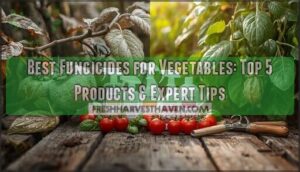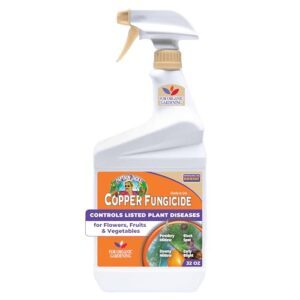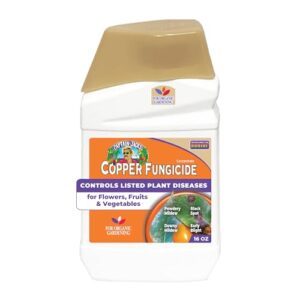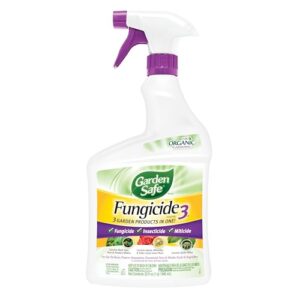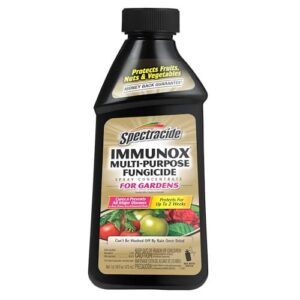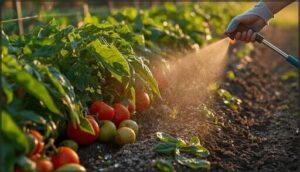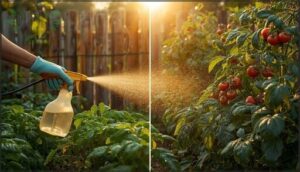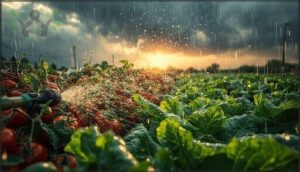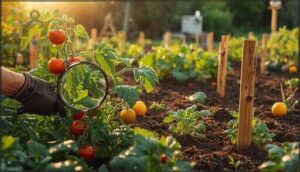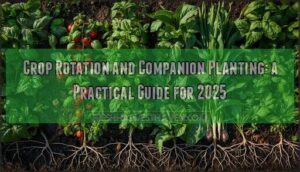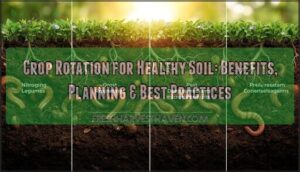This site is supported by our readers. We may earn a commission, at no cost to you, if you purchase through links.
You’ve watched your tomatoes start strong, only to find white powder creeping across their leaves by midsummer. Or maybe blight turned your cucumber vines into withered brown stalks overnight. Fungal diseases don’t just slow down your garden—they can wipe out months of work in days.
The good news? The right fungicide can stop these problems before they spiral out of control. But walk into any garden center and you’ll face shelves packed with bottles promising miracles, each with different active ingredients, application methods, and coverage claims. Some work fast but wash off in the rain, while others protect for weeks but cost three times as much.
Choosing the best fungicides for vegetables means matching the product to your specific disease, your gardening style, and your budget—so your harvest makes it from garden to table.
Table Of Contents
- Key Takeaways
- Top 5 Fungicides for Vegetables
- How to Choose The Right Fungicide
- Effective Fungicide Application Methods
- Preventing Disease and Fungicide Resistance
- Frequently Asked Questions (FAQs)
- What is the best garden fungicide?
- Can fungicides be used in vegetable gardens?
- How do I choose the right fungicide for my vegetable garden?
- Where can I find fungicides?
- What is southern AG garden friendly fungicide?
- What is Garden safe fungicide3?
- What is a good fungicide for vegetables?
- What’s the best fungicide for tomato plants?
- When to apply fungicide to vegetable garden?
- Which fungicide is best for vegetable crops?
- Conclusion
Key Takeaways
- Fungal diseases can destroy vegetable gardens quickly, but choosing the right fungicide—whether copper-based, neem oil, or synthetic options like myclobutanil—matched to your specific disease and gardening style prevents crop loss and protects your harvest.
- Accurate disease identification before treatment saves money and improves results, since spraying the wrong fungicide wastes resources while proper diagnosis enables targeted, effective control of blights, mildews, and leaf spots.
- Application timing matters more than product choice—preventative sprays before symptoms appear deliver up to 50% better disease control than waiting, and rotating fungicides by FRAC code prevents resistance that makes treatments fail.
- Integrated disease management combining fungicides with cultural practices like crop rotation, resistant varieties, and frequent monitoring cuts fungicide use by 33% while boosting yields up to 40% and reducing input costs.
Top 5 Fungicides for Vegetables
Protecting your vegetable garden from fungal diseases doesn’t have to be complicated. The right fungicide can save your plants from powdery mildew, rust, and other common problems that threaten your harvest.
Here are five proven fungicides that work well for home gardeners and small-scale growers.
1. Captain Jack’s Copper Fungicide Spray
Captain Jack’s Copper Fungicide Spray stands out as a top choice for vegetable gardens. This copper-based fungicide uses copper soap at 10% concentration to fight diseases like powdery mildew, blight, and leaf spot.
You’ll appreciate that it’s approved for organic gardening use and can be applied right up to harvest day. The disease spectrum covers tomatoes, beans, cucurbits, and more.
For best results, spray every 7 to 10 days, and always reapply after rain. Bonide Captain Jack’s Copper Fungicide offers solid protection with a reliable safety profile.
Best For: Organic vegetable gardeners who need a reliable, ready-to-use fungicide that controls common diseases and can be safely applied up to harvest day.
- Works on a wide range of diseases including powdery mildew, blight, and leaf spot across many vegetable types like tomatoes, beans, and cucurbits.
- OMRI-certified for organic gardening and safe to use right up to harvest day, giving you flexibility in your spray schedule.
- Ready-to-use spray bottle makes application quick and easy without any mixing required.
- Needs reapplication every 7-10 days and after every rainfall, which can get time-consuming and expensive during wet seasons.
- Some users report the spray bottle empties quickly and find the price point higher than they’d like for regular use.
- Can cause foliage damage if overused or applied incorrectly, especially on sensitive plants, so you need to follow label directions carefully.
2. Bonide Captain Jack Copper Fungicide
The concentrated formula version packs 8% elemental copper as copper octanoate, giving you stronger coverage with fewer applications. You’ll mix it with water yourself, which saves money over time.
This copper-based fungicide delivers excellent copper soap efficacy against blight, downy mildew, and leaf spot in your vegetable gardens. It’s OMRI-listed for organic gardening approval, so you can use it confidently in certified plots.
The crop safety profile is solid—apply every 7 to 10 days, spray morning or evening to prevent leaf burn, and remember to coat leaf undersides thoroughly.
Best For: Organic gardeners who need reliable disease prevention on vegetables, fruits, and ornamentals without sacrificing food safety or harvest timing.
- OMRI-listed for organic gardening with approval to use right up to harvest day, giving you continuous protection without waiting periods.
- Tackles a wide range of common diseases like blight, powdery mildew, and black spot with 8% copper octanoate that’s gentler on plants than other copper products.
- Concentrated formula stretches your dollar—you mix it yourself and get more applications per bottle than ready-to-use versions.
- Requires careful timing and technique to avoid leaf burn, meaning you’ll need to spray early morning or evening and follow directions closely.
- Not safe for bees or beneficial insects, so you’ll want to apply strategically to minimize harm to your garden’s helpful bugs.
- Needs reapplication every 7–10 days for effective control, which means more frequent maintenance compared to some synthetic alternatives.
3. Garden Safe Fungicide Insecticide Miticide
Garden Safe Brand Fungicide3 is a three-in-one product that works as a fungicide, insecticide, and miticide—tackling fungal diseases and common pests in one bottle. It contains 0.9% neem oil, a broad-spectrum biopesticide trusted in organic gardening.
You’ll control black spot, powdery mildew, rust, aphids, and whiteflies on your vegetable gardens with application intervals of 7 to 14 days. The safety profile is excellent: zero-day pre-harvest interval and low environmental impact.
Apply morning or evening to avoid leaf burn—complete coverage is key for results.
Best For: Home gardeners looking for an organic, multi-purpose solution to manage fungal diseases and common pests on vegetables, fruits, flowers, and ornamentals without harsh chemicals.
- Three-in-one formula tackles fungal diseases, insects, and mites with a single product, saving you time and money on separate treatments.
- Zero-day pre-harvest interval means you can pick and eat your produce the same day you spray, with low toxicity for families and pets.
- Works well for organic gardening and breaks down quickly in sunlight, so it won’t linger in your soil or harm beneficial insects if applied at the right time.
- Effectiveness can be hit-or-miss depending on the pest or disease, and some users report it doesn’t work on every type of fungus or insect problem.
- Application timing matters—spray during high heat or bright sun and you risk burning leaves, plus you need thorough coverage or results drop off significantly.
- The smell can be pretty unpleasant, and some bottles have inconsistent spray mechanisms that make even application frustrating.
4. Spectracide Immunox Multi Purpose Fungicide Concentrate
If you’re looking for lasting protection with fewer applications, Spectracide Immunox Multi-Purpose Fungicide Concentrate delivers up to two weeks of disease control between sprays. The active ingredient, myclobutanil, addresses powdery mildew, rust, black spot, and blight across your vegetable garden—working both as a preventative and curative treatment.
Mix 1¼ fluid ounces per gallon of water and spray to runoff. It’s rainproof once dry, won’t wash away, and shows low toxicity to humans.
On cucurbits, you can apply right up to harvest day.
Best For: Gardeners who want a reliable, rainproof fungicide that provides up to two weeks of protection with each application.
- Effective against a broad range of common garden diseases, including powdery mildew, black spot, and rust.
- Rainproof once dry, so it stays on even after watering or rainfall.
- Can be applied to some crops, like cucurbits, right up to the day of harvest.
- Requires careful mixing and proper plant hydration to avoid burning foliage.
- Not as effective during periods of heavy rain or prolonged cloudy weather.
- Needs a 30-day wait before planting new crops in treated soil.
5. Grower’s Ally Plant Fungicide Spray
Among the latest organic options, Grower’s Ally Fungicide Spray stands out for vegetable gardens. It relies on citric acid efficacy to help wipe out powdery mildew and more, all while earning OMRI organic certification.
Application guidelines are simple: spray during any growth stage, even on harvest day, and skip the wait. The safety profile impresses—no heavy metals, no re-entry interval.
That’s one reason for strong market adoption among growers who want a reliable, food-safe fungicide with proven results and peace of mind.
Best For: Home gardeners and commercial growers seeking an organic, food-safe fungicide that’s easy to use and works on all crop stages.
- Effective against powdery mildew and other common plant diseases with no wait time before harvest.
- OMRI Listed and residue-free, suitable for both organic farming and same-day harvest.
- Minimal safety precautions needed; safe for pollinators and workers.
- May not fully prevent mildew from returning if environmental conditions aren’t resolved.
- Some plants may lose leaves if already heavily infected.
- Product can spoil if not used quickly or stored properly.
How to Choose The Right Fungicide
Choosing the right fungicide for your garden starts with knowing what you
Importance of Accurate Disease Diagnosis
Think of diagnostic accuracy as your anchor in plant disease control. Mistaken identity with common vegetable diseases often leads to wasted sprays and rising costs.
Early, precise vegetable disease identification—using timely sampling protocols and the latest technology—keeps your management decisions sharp. Accurate plant disease diagnostics are your first defense, saving not just your harvest, but your bottom line as well.
Accurate plant disease diagnostics are your first defense, saving not just your harvest, but your bottom line as well
Early detection can support integrated crop management, improving resource efficiency.
Organic Vs. Synthetic Fungicides
When weighing organic fungicides against synthetics, consider both residue exposure and the microbial impact on your vegetable garden. Organic options align with organic gardening principles and help reduce chemical buildup, while synthetic fungicides often offer broader efficacy. Application frequency is another factor—synthetics typically require fewer sprays.
Market trends indicate a growing preference for organic choices, yet both types have their place. Many fruits and vegetables, including organic options, contain pesticide residue levels, highlighting the importance of informed decision-making.
Crop Compatibility and Safety Considerations
Selecting fungicides for your vegetable garden shouldn’t feel like threading a needle—small missteps with crop compatibility can risk phytotoxicity effects, nutrient uptake issues, or unsafe residue levels. Always follow regulatory limits, respect worker safety rules, and run a trial spray on a single plant before broad application.
Organic fungicides often offer safe gardening peace of mind against stubborn vegetable diseases.
Understanding Active Ingredients and Labels
Reading fungicide labels might seem tedious, but it’s your roadmap to effective disease control. Focus first on the active ingredient—this tells you what actually fights the fungus.
Then check dosage rates per acre and pre-harvest intervals to keep residues within EPA safety limits.
Label instructions also detail environmental impact warnings, required protective gear, and re-entry times to protect both you and beneficial organisms.
Effective Fungicide Application Methods
Choosing the right fungicide is only half the battle—how you apply it makes all the difference in protecting your vegetables. The method, timing, and equipment you use will determine whether your plants stay healthy or diseases take hold.
Let’s walk through the key application strategies that’ll help you get the most out of your fungicide treatments.
Spray, Dust, and Granular Applications
Each fungicide application method—spray, dust, or granular—works differently and fits specific needs on your vegetable farm. Sprays offer the best coverage uniformity, reaching over 85% of leaf surfaces when you use calibrated spray equipment properly. Here’s what you need to know about fungicide application methods:
- Sprays reduce disease by up to 88% and provide excellent residual control for 10–14 days
- Dusts cover only 60% effectively and lose 57% potency after moderate rain
- Granulars target soil-borne diseases with 45–65% reduction, lasting 21 days in drier soils
- Economic efficiency favors sprays—dusts need 28% more product for similar results
Consider environmental impact and application rates when choosing your method for long-term success.
Timing and Frequency for Optimal Results
Once you’ve chosen your application method, disease development determines when you spray. Start preventative fungicide applications before symptoms appear—you’ll see up to 50% better disease control than waiting.
During peak vulnerability, like early flowering, apply every 7–14 days depending on weather influence. Critical windows matter most: two well-timed applications often beat weekly sprays all season.
Always respect pre-harvest intervals to keep residues safe.
Equipment and Coverage Tips
After nailing your application timing, the right tools make all the difference. Sprayer calibration an
Weather Resistance and Rain Fastness
Even the best fungicides for vegetables lose their punch when rain hits too soon. Most contact fungicides need 1 to 4 hours to stick, depending on canopy dryness and formulation. Rainfall within an hour can slash fungicide efficacy by 50% or more.
Systemic absorption helps, but heavy downpours still wash away protection.
Adjuvant impact matters too—surfactants boost weather resistance of fungicides and help your rainproof formula hold tight.
Preventing Disease and Fungicide Resistance
Protecting your vegetables from disease isn’t just about spraying fungicides—it’s about working smarter to keep diseases at bay for the long haul. One of the biggest challenges you’ll face is fungicide resistance, which happens when fungi adapt and your treatments stop working.
Let’s look at four proven strategies that’ll help you prevent disease while keeping your fungicides effective season after season.
Rotating Fungicides and FRAC Codes
Rotating fungicides keeps diseases guessing and protects your vegetables from resistance. FRAC codes, found on every product label, tell you each fungicide’s mode of action. By alternating at least three different FRAC groups each season, you’ll reduce resistance risk by up to 85%.
Multi-site fungicides like copper work great in rotation because they attack pathogens multiple ways, making resistance nearly impossible.
Integrated Disease Management Strategies
When you combine fungicides with biological controls, cultural practices, and resistant varieties, disease management becomes more powerful and sustainable. This approach cuts fungicide use by up to 33% while boosting yields by 15-40% on vegetable crops. You’ll see real economic benefits—growers save nearly 18% on input costs.
Preventive measures like crop rotation and compost also suppress soilborne diseases by 48%, stopping fungicide resistance before it starts.
Monitoring for Early Signs of Fungal Disease
Catching fungal diseases before visual symptoms appear can save you money and crops. Spectral imaging detects infections days earlier than your eyes can, with accuracy reaching 98% by day eleven. Electronic biomarker approaches identify pathogens over a week before early blight or other signs show up.
Check your plants every two to three days—frequent monitoring boosts disease prevention and protects plant health.
Safe Usage and Post-Harvest Intervals
Safe fungicide usage protects your harvest and everyone handling it. Following preharvest intervals—the mandatory wait between spraying and harvesting after fungicide use—keeps residue monitoring in check and ensures tolerance levels stay within EPA limits. Label compliance matters:
- Check PHI requirements (0-14 days depending on product)
- Wear proper protective gear during application
- Follow dosage instructions exactly as written
- Store treated produce correctly to manage storage effects
- Document applications for worker safety and traceability
Fungicide safety guidelines aren’t just paperwork—they’re your assurance that vegetables are safe to eat.
Frequently Asked Questions (FAQs)
What is the best garden fungicide?
You’ll want to match the fungicide to your specific disease challenge. Bonide sulfur delivered 100% control against powdery mildew in university trials, making it a standout choice for vegetable disease prevention.
Can fungicides be used in vegetable gardens?
Yes, fungicides work well in vegetable gardens when you apply them correctly. Over 80% of U.S. vegetable crops receive fungicide treatments each season, making them essential for protecting your harvest from fungal diseases.
How do I choose the right fungicide for my vegetable garden?
Picking the perfect fungicide for your vegetable crop protection depends on disease identification, choosing organic options or synthetics, checking crop safety, understanding labels, and practicing resistance management through proper fungicide selection.
Where can I find fungicides?
You’ll find fungicides at major retailers like Lowe’s and Home Depot, which dominate retailer market share, plus online platforms, regional suppliers, and extension services.
Agrodealer workshops also guide fungicide selection for your vegetable garden.
What is southern AG garden friendly fungicide?
Looking for a biological alternative to harsh chemicals? Southern AG Garden Friendly Fungicide uses beneficial bacteria to protect vegetable plants from fungal diseases like powdery mildew, blight, and root rot—safely and organically.
What is Garden safe fungicide3?
Garden Safe Fungicide3 is a ready-to-use spray with neem oil extract that controls fungal diseases like powdery mildew and black spot.
It’s approved for organic gardening and safe to use up to harvest day.
What is a good fungicide for vegetables?
You’ll protect your vegetables best with chlorothalonil-based fungicides like Bravo or copper products such as Kocide 3000—both tackle over 80% of vegetable crops’ toughest diseases when applied correctly.
What’s the best fungicide for tomato plants?
For tomato late blight and early blight, chlorothalonil-based fungicides and mancozeb reduce disease incidence considerably.
Rotate active ingredients by FRAC code to prevent resistance trends, and choose organic options like copper when appropriate for your garden.
When to apply fungicide to vegetable garden?
Apply fungicide application timing before disease symptoms appear, usually every 7–14 days during high-risk weather. Field monitoring and preventative fungicides protect healthy tissue better than curative treatments after infection starts.
Which fungicide is best for vegetable crops?
Like choosing the right tool from your grandfather’s shed, picking the best fungicide for vegetable crops depends on your specific disease, whether you prefer organic alternatives or broad-spectrum options, and your crop type.
Conclusion
Like a shield raised before battle, the best fungicides for vegetables stand between your harvest and disaster. You’ve learned which products tackle specific diseases, how to apply them effectively, and why rotating treatments protects your plants long-term.
Now it’s your turn to act. Scout your garden weekly, catch problems early, and spray with confidence. Your tomatoes, cucumbers, and squash depend on it—and they’ll reward you with bins full of healthy produce.
- https://www.linkedin.com/pulse/plant-fungicides-market-size-application-2025-verdant-echo-ventures-7bjlc
- https://pmc.ncbi.nlm.nih.gov/articles/PMC6536136/
- https://croplifefoundation.wordpress.com/wp-content/uploads/2012/07/completed-fungicide-report.pdf
- https://croplifefoundation.files.wordpress.com/2012/07/fungicide-executive-summary.pdf
- https://www.cdpr.ca.gov/wp-content/uploads/2024/12/pur_data_summary_2020.pdf

